Turkey’s plan to construct Ilisu Dam over Tigris River can pose a serious environmental threat to Iraq and eventually Iran by reducing the entry of Tigris water to Iraqi territory by 56%, an official at the Department of Environment said.
Ilisu Dam is under construction. Tigris flows south from the mountains of southeastern Turkey through Iraq. Before flowing into the Persian Gulf, the river joins the Euphrates to form the Arvandroud (aka Shatt-al-Arab) whose water stream along with that of Karkheh River in Khuzestan Province feed Hour al-Azim Wetland on the Iran-Iraq border.
Hamid Jalalvandi, director for environmental impact assessment at DOE, explained that once IIisu Dam is built over the river, Hour al-Azim Wetland that has already been struggling with drought conditions for years will eventually dry up, triggering a major environmental catastrophe in Iran, Mehr News Agency reported.
"The dam will not only pose environmental threat to southern Iran, but will also affect the northern and northwestern regions," he said.
Ilisu Dam is part of Turkey's large-scale project known as GAP (Guneydogu Anadolu Projesi) or the Southeastern Anatolia Project that involves the construction of 22 dams on the Euphrates and Tigris, as well as 19 hydropower stations. It was estimated to be completed in 2017.
As a result of the project, tens of thousands of local residents will be displaced and the ancient city of Hasankeyf will be submerged beneath a vast reservoir. The project has drawn widespread criticism from environmental groups in Turkey and abroad, which are concerned that it will threaten endangered species, reduce downstream water flows and cause irreparable ecological damage to the Tigris River basin.
The Turkish Foreign Ministry, however, has defended the project on its website. It maintains that Ilisu is not designed for irrigation and only for power generation, therefore, the water passing through the turbines has to flow back into the riverbed. Besides, river water flowing into Iraq and Syria will not be polluted because the use of water for hydropower is non-polluting.
It also points to certain benefits of the scheme such as holding back water during the winter floods and releasing it during the summer droughts as well as avoiding the emission of millions of tons of greenhouse gases from alternative thermal power plants.
GAP's Threats
GAP has already been blamed for having adverse environmental impacts in the region, including dust storms. From time to time, Syria, Iraq and Turkey were embroiled in tensions due to GAP.
Iran has not been immune from the effects of the plan and dust rising from the dried-out plains of neighboring countries is frequently carried by wind toward Iran, blanketing the skies of cities reaching as far as Tehran.
"Ilisu is not the only issue but the entire scheme that includes multiple dams is a major concern for us," Jalalvandi said.
He noted that Iran’s concerns have been communicated through the Foreign Ministry to Turkish authorities as well as the United Nations and negotiations are still underway. He did not provide details about the achievements, if any, of the talks.
An online petition also aims to appeal to the United Nations Secretary-General Antonio Guterres to intervene and pressure the Ankara government to abandon its reckless dam construction.
"If the petition manages to collect enough signatures, the case can be brought up in the International Court of Justice," he added.
However, Jalalvandi did not give an assurance whether the projects will be interdicted, as many GAP plans are near completion.
Turkey has been quick to shift the blame of dust storms on other causes of the phenomenon.
Caglar Fahri Cakiralp, Turkish consul general in Tabriz, told the news agency that to say Turkey is the source of particle pollution in Iran has not been scientifically proven.
"Global data show that the drylands of North Africa and the Arabian Peninsula [in which Turkey's developmental projects have no part] are responsible for 70% of dust storms in the region and the world, although there are hotspots in Iraq, Iran and Syria too that pose a threat to Turkey itself," he said, adding that climate change and global warming are also major contributors to the natural incidence.
Cakiralp noted that the Turkish delegation that took part in the International Conference on Combating Sand and Dust Storms in Tehran on 3-5 July 2017 has clarified the ambiguities about the country's role in the expansion of dust storms.


